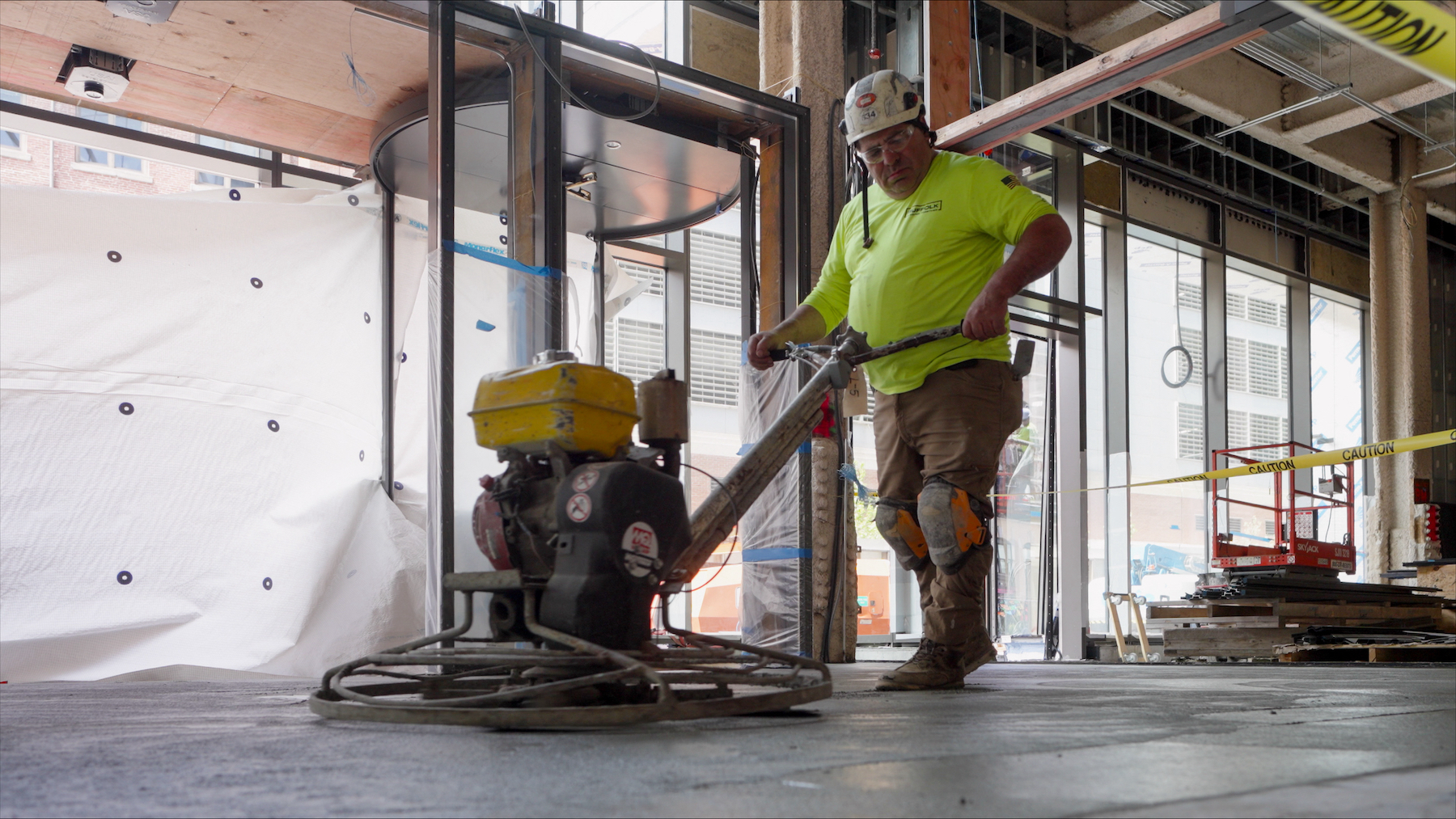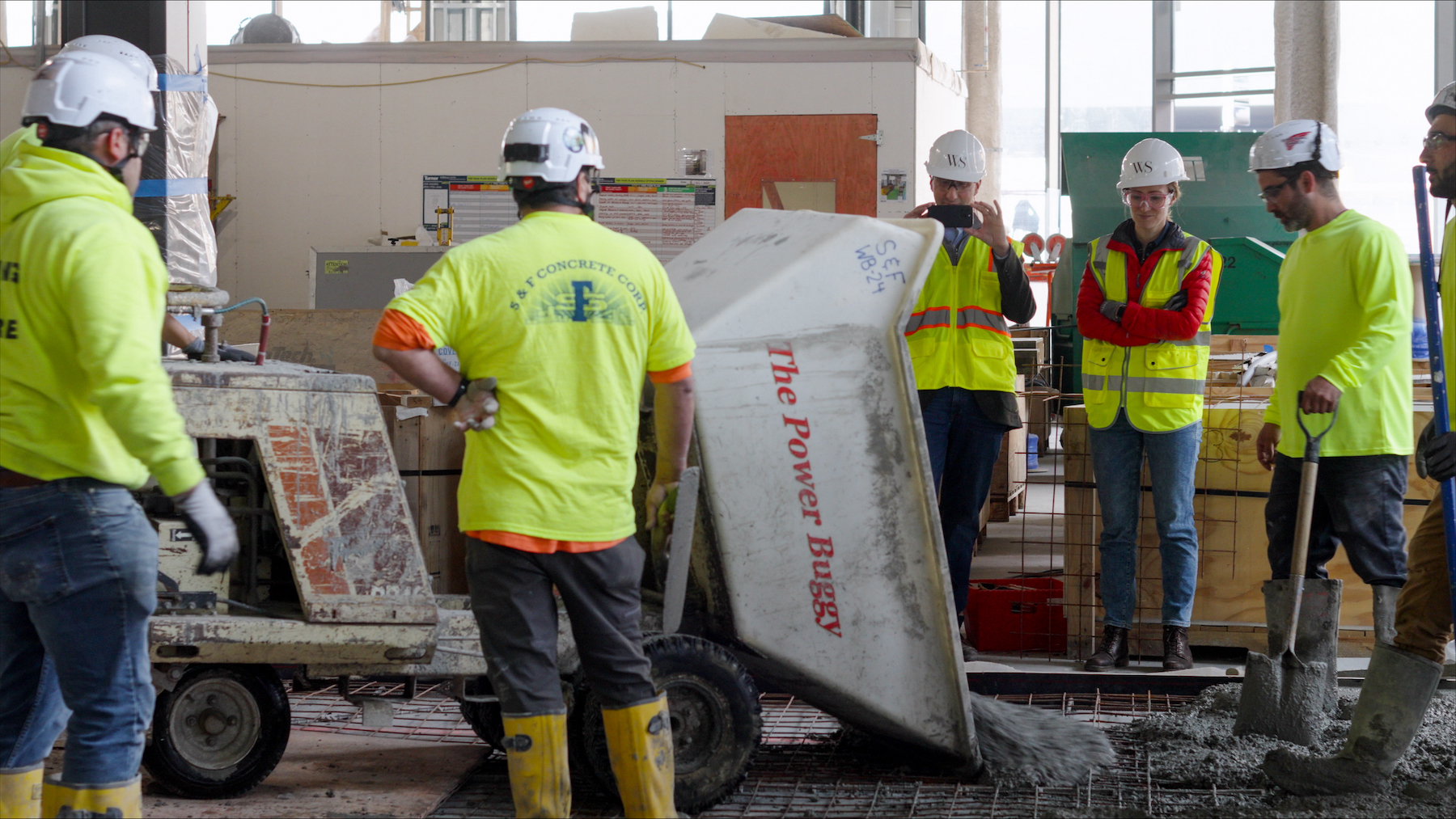Earlier this month, a 575-sf patch of concrete was poured as part of a public space known as the Paseo, inside One Boston Wharf Road, a 707,000-sf 17-story building in Boston’s Seaport district that is scheduled for completion later this year. Amazon will be the building’s sole tenant.
What makes this newsworthy, you ask? Well, for one thing, One Boston Wharf Road, developed by WS Development, will be Beantown’s largest Net Zero Carbon office building. Its goal is to reduce greenhouse gas emissions by more than 90 percent below code requirements and eliminate 5.1 million pounds of CO2 annually. (WS Development recently announced that it had purchased renewably generated electricity for all electric power used by its Seaport portfolio.)
Also see: AGC releases decarbonization playbook to help assess, track, reduce GHG emissions
The concrete installation represents the first commercial application of low-carbon cement manufactured by Sublime Systems, a business that the Massachusetts Institute of Technology spun out as an enterprise in 2010.
Production of cement currently accounts for 8 percent of global CO2 emissions, mostly caused by the intense temperatures required to make cement clinker from limestone, a common ingredient in concrete. Sublime Systems, which is based in Somerville, Mass., claims that its Sublime Cement, the product's marketing name, avoids traditional cement’s major emissions sources, limestone feedstock and fossil-fueled kilns, by applying electrochemistry to extract cementitious ingredients from non-carbonate materials, without degrading the properties that make concrete the most-used building material worldwide.
Sublime Systems’ technology makes ASTM C1157-compliant cement, a drop-in replacement for Portland Cement in concrete. The company, which was incorporated four years ago, has raised more than $140 million from tech investors, and cooperative agreements with several U.S. Department of Energy programs. The company’s pilot plant has a 250-ton annual production capacity, and Sublime Systems is developing a 30,000-ton capacity commercial facility that will open in Holyoke, Mass., in early 2026.
“We and Sublime share the same vision and mission,” said Yanni Tsipis, a Senior Vice President at WS Development and a lecturer at the MIT Center for Real Estate. “We have an opportunity to showcase the most forward—thinking low-carbon building technology on the planet in the public space, at the heart of the building. This partnership epitomizes the value of technology transfer from incubator to industry.”
Educating the public about lowering carbon

The floor of the Paseo, in which Sublime Cement is installed, will be marked with educational material explaining the significance of decarbonized cement in the battle against climate change. The Paseo will lead to a new 1.5-acre park called The Rocks at Harbor Way that will be the focal point of a one-third-mile promenade that connects to the water’s edge. (James Corner Field Operations came up with this concept for Harbor Way.) One Boston Wharf Road will feature 77,000 sf of retail space.
One Boston Wharf Road is adjacent to 11 Harbor Way, a 525,000-sf, 17-story office tower that WS Development completed in the spring of 2022.
Related Stories
| Oct 7, 2011
GREENBUILD 2011: Transparent concrete makes its North American debut at Greenbuild
The panels allow interior lights to filter through, from inside.
| Oct 4, 2011
GREENBUILD 2011
Click here for the latest news and products from Greenbuild 2011, Oct. 4-7, in Toronto.
| Sep 20, 2011
Jeanne Gang wins MacArthur Fellowship
Jeanne Gang, a 2011 MacArthur Fellowship winner described by the foundation as "an architect challenging the aesthetic and technical possibilities of the art form in a wide range of structures."
| Jan 19, 2011
Large-Scale Concrete Reconstruction Solid Thinking
Driven by both current economic conditions and sustainable building trends, Building Teams are looking more and more to retrofits and reconstruction as the most viable alternative to new construction. In that context, large-scale concrete restoration projects are playing an important role within this growing specialty.
| Aug 11, 2010
New data shows low construction prices may soon be coming to an end
New federal data released recently shows sharp increases in the prices of key construction materials like diesel, copper and brass mill shapes likely foreshadow future increases in construction costs, the Associated General Contractors of America said. The new November producer price index (PPI) report from the Bureau of Labor Statistics provide the strongest indication yet that construction prices are heading up, the association noted.
| Aug 11, 2010
Economic conditions to cause drag on cement consumption
The conditions facing the construction industry are likely to remain weak for another year or more, causing a drag on cement consumption, according to the most recent economic forecast from Skokie, Ill.-based Portland Cement Association (PCA).
| Aug 11, 2010
PCA partners with MIT on concrete research center
MIT today announced the creation of the Concrete Sustainability Hub, a research center established at MIT in collaboration with the Portland Cement Association (PCA) and Ready Mixed Concrete (RMC) Research & Education Foundation.
| Aug 11, 2010
Rice concrete can cut greenhouse emissions
Rajan Vempati of ChK Group, Inc. in Plano, Texas, and a team of researchers found a way to make nearly carbon-free rice husk ash for concrete, which can lead to a boom in green construction.
| Aug 11, 2010
American Concrete Institute forms technical committee on BIM for concrete structures
The American Concrete Institute (ACI) announces the formation of a new technical committee on Building Information Modeling (BIM) of Concrete Structures.
| Aug 11, 2010
Proposed EPA regulations threaten thousands of jobs, says Portland Cement Association
A proposed hazardous air pollutant regulation for the cement industry undermines the balance between environmental protection and economic viability, according to statements the Portland Cement Association (PCA) is issuing this week at a series of public hearings.











